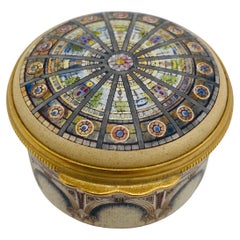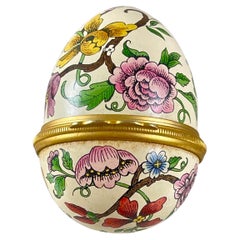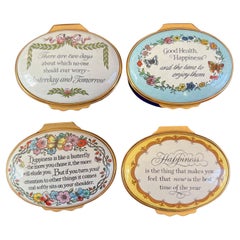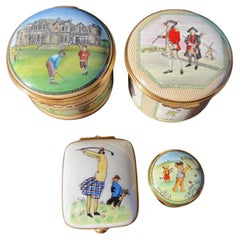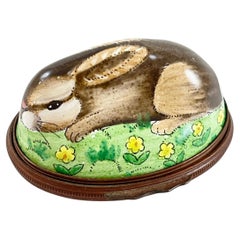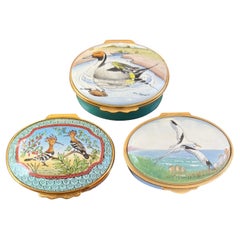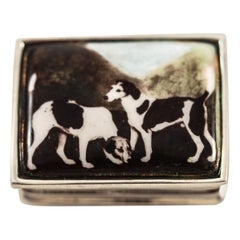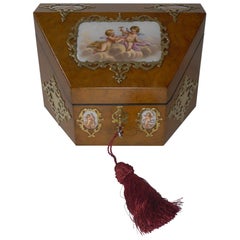Halcyon Days Boxes
to
7
7
6
2
3
1
6
4
4
4
2
7
7
7
7
Height
to
Width
to
7
7
7
4
217
131
91
70
Creator: Halcyon Days
Halcyon Days Fine Enamel British Pillbox National History Museum of Los Angeles
By Halcyon Days
Located in San Juan Capistrano, CA
Stunning little porcelain box by Halcyon Days Enamels. The inside lid is inscribed "National History Museum of Los Angeles County 1913-1988." The bottom o...
Category
20th Century English Art Nouveau Halcyon Days Boxes
Materials
Porcelain
Halcyon Days English Bilston Enamel Floral Egg Trinket Box
By Halcyon Days
Located in Philadelphia, PA
From Halcyon Days, a Bilston enamel trinket box shaped as an egg, Stoke-on-Trent, England, circa 1970-1980s.
Established in the 1950s, Halcyon Days Ltd ...
Category
1970s English International Style Vintage Halcyon Days Boxes
Materials
Copper
Vintage English Halcyon Days Enamel Boxes With Sentimental Quotes, Floral Decor
By Halcyon Days
Located in Morristown, NJ
Set of 4 vintage Halcyon Days Enamel Boxes.
"Yesterday and Tomorrow" Halcyon Days Enamel Box
Shape: Oval
Design: A floral and vine motif decorate...
Category
Late 20th Century English Victorian Halcyon Days Boxes
Materials
Metal, Enamel
Set of Four Golf-Themed Enamel Boxes – Halcyon Days & Limoges Collectibles
By Halcyon Days
Located in Morristown, NJ
Set of Four Golf-Themed Enamel Boxes – Halcyon Days & Limoges Collectibles
This charming set of four golf-themed enamel boxes includes three English Halcyon Days pieces and one Limoges, France box, making it a perfect collection for golf enthusiasts and collectors of fine enamelware. Each piece is crafted with exquisite detailing and hand-painted designs celebrating golf's rich history and playful spirit.
1. Halcyon Days "William Innes & Blackheath Golf Club" Enamel Box
Design: Features William Innes, a Member of Parliament and Captain of the Society of Golfers in 1778 at the Royal Blackheath Golf Club.
Interior: The inside lid bears the inscription, referencing a painting by Lemuel Francis Abbot, along with a note about King James I introducing golf to England from Scotland in 1608.
Exterior: Decorated with vintage golf illustrations, bordered by green and gold accents.
Base: Marked Halcyon Days Enamels, England.
Original box retained.
2. Halcyon Days "The Old Course, St. Andrews" Enamel Box
Design: Features an elegant map of the Old Course at St. Andrews, the world’s most famous golf course.
Interior: Inscribed with historical details about St. Andrews, including its role in the Open Championship and the founding of The Royal and Ancient Club House in 1854.
Base: Marked Halcyon Days Enamels, England.
Original box retained.
3. Halcyon Days "Golfing Teddy Bears" Enamel Box
Design: A whimsical hand-painted scene of two teddy bears playing golf, one in a striped referee shirt and the other in red golf attire.
Interior: Features a black-and-white illustration of a teddy bear holding a golf club.
Base: Marked Halcyon Days Enamels, England.
4. Limoges "Lady Golfer" Hand-Painted Enamel Box
Design: Features a female golfer in a classic plaid skirt and yellow sweater, preparing for a swing while her caddie watches nearby.
Interior: Painted with a small golf ball on a tee.
Backstamp: Marked "Limoges France - Peint Main" (Hand-Painted) with a golf club illustration.
Set Features:
✔ Hand-Painted & Hand-Decorated
✔ Fine English & French Enamelware
✔ Historical & Whimsical Golf Themes
✔ Perfect for Collectors & Golf Lovers
✔ Excellent Condition – Includes Original Box for St. Andrews Piece
This set celebrates the tradition, history, and charm of golf, making it a fantastic addition to any golf memorabilia collection or fine enamelware display.
Dimensions:
2"dia x 1.25"h (Two larger Halcyon Days Boxes...
Category
Late 20th Century English Country Halcyon Days Boxes
Materials
Metal, Enamel
Halcyon Days English Bilston Enamel Rabbit Trinket Box
By Halcyon Days
Located in Philadelphia, PA
From Halcyon Days, a Bilston enamel trinket box shaped as a rabbit, Stoke-on-Trent, England, circa 1970-1980s.
Established in the 1950s, Halcyon Days ...
Category
1970s English International Style Vintage Halcyon Days Boxes
Materials
Copper
Group of Three Vintage English Enamel Boxes Hand-Painted Bird-Themed Designs
By Halcyon Days
Located in Morristown, NJ
Set of Three Enamel Boxes – Hand-Painted Collectible Bird-Themed Designs
A set of three English enamel boxes showcasing the mastery in fine English enameling, each featuring a unique and beautifully hand-decorated bird motif. A perfect addition for collectors of ornithological art, fine enamelware, or vintage decorative objects.
Hoopoe Bird Enamel Box
Design: This vibrant enamel box features a pair of Hoopoe birds perched among lush foliage and berries, framed by an elegant red and blue border with intricate scrollwork.
Interior: The inside lid is decorated with a delicate black-and-white illustration of a Hoopoe bird.
Base: Stamped Halcyon Days Enamels...
Category
Late 20th Century English Victorian Halcyon Days Boxes
Materials
Metal, Enamel
Pair of Halcyon Days Enamel Boxes – Friendship & Wisdom Quotes – Hand-Painted
By Halcyon Days
Located in Morristown, NJ
Pair of Halcyon Days Enamel Boxes – Friendship & Wisdom Quotes – Hand-Painted Collectible
This exquisite pair of Halcyon Days enamel boxes featur...
Category
Late 20th Century English Victorian Halcyon Days Boxes
Materials
Metal, Enamel
Related Items
Sterling Pillbox
Located in Brooklyn, NY
We are delighted to offer this sterling silver English pillbox. The lid is made of sterling and has an enamel cameo design. Two hounds are seen next to each...
Category
21st Century and Contemporary American Halcyon Days Boxes
Materials
Sterling Silver
Antique English Burr Walnut & Hand Painted Porcelain Stationery Box, circa 1850
Located in Bath, GB
A quite wonderful and romantic stationery box, ready to grace the finest of desk-tops.
Made from burr walnut the wedge shaped box is smothered in fine quality polished brass mount...
Category
1850s English Early Victorian Antique Halcyon Days Boxes
Materials
Brass
$3,228 Sale Price
20% Off
H 6.25 in W 10 in D 6 in
Stuart Devlin Set of Twelve Silver and Silver-Gilt "Twelve Days of Christmas"
By Stuart Devlin, Cartier
Located in North Miami, FL
Introducing an extraordinary and complete collection of Twelve English silver and silver-gilt "Twelve Days of Christmas" gift boxes, presented...
Category
1970s English Vintage Halcyon Days Boxes
Materials
Sterling Silver
$89,500 / set
H 3.5 in W 5 in D 5 in
Antique White Opaline Glass Box with Blue Floral Enamel Decoration, 1890
Located in Hamburg, DE
Luxurious and rare antique opal glass box. This kind of jewelry boxes was mainly made in France, Italy and formerly Bohemia. They were made from the early 19th century to the early 2...
Category
1880s Italian Belle Époque Antique Halcyon Days Boxes
Materials
Metal
French Antique Ormolu and Limoges Enamel Jewellery Box
By Limoges
Located in Newark, England
LIMOGES ENAMEL PANELS
From our Decorative collection, we are delighted to offer this French Napoleon III Ormolu and Enamel Jewellery Box. The Jewellery...
Category
Late 19th Century French Napoleon III Antique Halcyon Days Boxes
Materials
Enamel, Ormolu
Fine Antique English South Staffordshire or Battersea Enamel Snuff Box
Located in Lambertville, NJ
An excellent quality late 18th or early 19th century Battersea enamel snuff or patch box. The pink enamel background with white enamel lattice and a raised gold around the hand paint...
Category
Early 19th Century English Regency Antique Halcyon Days Boxes
Materials
Bronze, Enamel
$960 Sale Price
20% Off
H 1.5 in W 2.5 in D 1.7 in
19C Anglo Ceylonese Sewing Box of Museum Quality
Located in Dallas, TX
Presenting an absolutely stunning 19c Anglo Ceylonese sewing box of museum quality.
Made in Ceylon (now Sri Lanka) circa 1860, this is one of the finest sewing boxes of it’s kind that we have ever seen!
The box is made from coromandel wood (an exotic hardwood found in Ceylon) and has a serpentine edging all over the front, back and sides.
Very often the lids/tops of these boxes suffer cracks due to shrinkage but this one is near perfect with no crack in the lid/top. There is some evidence of natural shrinkage but that is around the edges of the lid/top.
It is when you open this box that it reveals it’s true beauty, quality and treasure !
The inside of the lid/top is heavily and beautifully decorated with inlaid bone in scrolling floral patterns which have then been hand painted with red and black ‘lac’ ink. The central medallion is a circle of inlaid specimen exotic hardwoods radiating towards a central bone and hand painted flower. The circle is edged in bone, wood and silver chevrons.
What makes this box Exceptionally rare is that it contains 3 lift out base sections. Normally, there would be a maximum of 2.
The first tray/section is clearly for the purposes ancillary to sewing with a pair of sections with bone spools for thread etc. There are 17 other lidded compartments with each one highly decorated using hand painted bone and specimen woods to replicate tortoiseshell.
The first tray lifts out to reveal a second removeable tray which is made up of a pair of open sections and 8 specimen wood lidded sections each with chevron banding.
The third tray is a smaller tray underneath with 14 lidded compartments each with hand painted bone and specimen wood inlaid lids again, replicating the look of tortoiseshell. Again they are banded with a chevron border.
This is a museum quality piece !
It is in fantastic condition for it’s age with the minor shrinkage to the edges of the lid/top, some finger pulls missing and some very minor cracks to the tray lids and bases but nothing that in any way detracts from the piece. No key.
Dimensions: Closed the box is 16.75 inches wide, 11.25 inches deep and 7.5 inches high
Fully open the box is 16.5 inches high, 16.75 inches wide and 11.4 inches deep
Anglo-Indian and ceylonese boxes: Anglo Indian boxes were made in India for the English residents from the early part of the 18th century. They were brought back or sent back to England usually by the people who had commissioned them. From the beginning of the nineteenth century they were imported more commercially, although not in any significant numbers until the middle decades. They were very highly valued, especially the early ones, to the extent that the designs were copied on late 19th and early 20th century tins.
Anglo-Indian boxes normally consist of 3 main types:-
(1) Most of the best and highest quality Anglo-Indian boxes in the 18th and 19th centuries were made in Vizagapatam, India, renowned for its exquisite craftsmanship in using ivory and tortoiseshell and lac decoration. These are referred to as ‘Vizagapatam Boxes...
Category
Mid-19th Century Sri Lankan Anglo-Indian Antique Halcyon Days Boxes
Materials
Silver
French Limoges Hand Painted Floral Trinket Box
By Limoges
Located in Haddonfield, NJ
Charming Limoges Porcelain Trinket Box painted in pinks, purples and greens. Upon opening the box there is a cute flower design inside as well. The box is marked Peint Main Limoges F...
Category
Mid-20th Century French French Provincial Halcyon Days Boxes
Materials
Gold, Brass
Antique English Large Tunbridge Box With Marquetry Inlay
By Tunbridge Ware
Located in Bridgeport, CT
An antique English Tunbridge box with geometric inlay, hinged lid, red velvet interior, felted bottom and comes with working key. The box with a diamond form inlaid medallion flanked...
Category
19th Century English Victorian Antique Halcyon Days Boxes
Materials
Velvet, Wood
Antique Enameled Glass Trinket Box
Located in Rochester, NY
Antique emerald green glass trinket box. 19th century.
Category
19th Century European Antique Halcyon Days Boxes
Materials
Glass
Marie Antionette Style Limoge Box
By Limoges
Located in Asheville, NC
Beautiful porcelain Limoges box hand-painted rose flowerettes adorned with painted gold designs and gold hardware.
Category
18th Century and Earlier French Antique Halcyon Days Boxes
Vintage Chinoiserie Jewelry Box, Wood with Jade Inlay and Brass Decor
Located in Clifton Springs, NY
Vintage Chinese jewelry box features solid wood body with finger joint corners, carved inlay on the lid, and brass applique decor on the corners and around the inlay. The box is equi...
Category
Mid-20th Century Chinese Chinoiserie Halcyon Days Boxes
Materials
Stone, Jade, Brass
Halcyon Days boxes for sale on 1stDibs.
Halcyon Days boxes are available for sale on 1stDibs.
